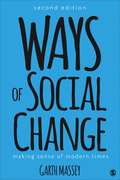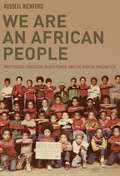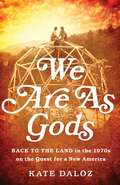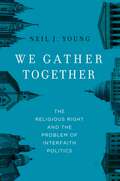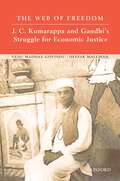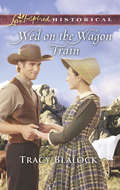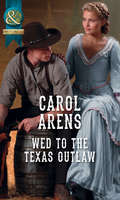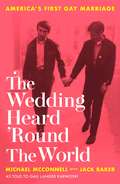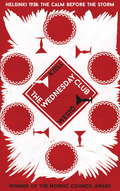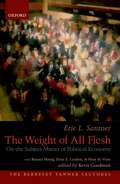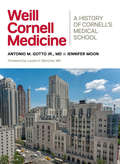- Table View
- List View
The Way We Never Were: American Families and the Nostalgia Trap
by Stephanie CoontzThe definitive edition of the classic, myth-shattering history of the American family Leave It to Beaver was not a documentary, a man's home has never been his castle, the "male breadwinner marriage" is the least traditional family in history, and rape and sexual assault were far higher in the 1970s than they are today. In The Way We Never Were, acclaimed historian Stephanie Coontz examines two centuries of the American family, sweeping away misconceptions about the past that cloud current debates about domestic life. The 1950s do not present a workable model of how to conduct our personal lives today, Coontz argues, and neither does any other era from our cultural past. This revised edition includes a new introduction and epilogue, exploring how the clash between growing gender equality and rising economic inequality is reshaping family life, marriage, and male-female relationships in our modern era. More relevant than ever, The Way We Never Were is a potent corrective to dangerous nostalgia for an American tradition that never really existed.
Ways of Social Change: Making Sense of Modern Times (Second Edition) (PDF)
by Garth MasseyWays of Social Change is a primer for making sense of both rapidly moving events and the cultural and structural forces on which social life is built, while teaching critical thinking skills needed to understand social change. With an approach that is fresh, timely, challenging, and engaging, Ways of Social Change shows students how social change is both a lived experience and the result of our actions in the world. It invites the reader into the realm of social science, where clarification, understanding, and inquiry provide for both informed opinions and a path to effective involvement. The core of the book focuses on five forces that powerfully influence the direction, scope and speed of social change: science and technology, social movements, war and revolution, large corporations, and the state. A concluding chapter encourages students to examine their own perspectives and offers ways to engage in social change, now and in their lifetime.
The Ways We Think: From the Straits of Reason to the Possibilities of Thought (Journal of Philosophy of Education)
by Emma WilliamsThe Ways We Think critiques predominant approaches to the development of thinking in education and seeks to offer a new account of thought informed by phenomenology, post-structuralism and the ‘ordinary language’ philosophical traditions. Presents an original account of thinking for education and explores how this alternative conception of thought might be translated into the classroom Explores connections between phenomenology, post-structuralism and ordinary language philosophical traditions Examines the relevance of language in accounts of how we think Investigates the philosophical accounts of Gilbert Ryle, Martin Heidegger, John Austin and Jacques Derrida Draws upon experience of own teaching practice as philosopher-in-residence
The Ways We Think: From the Straits of Reason to the Possibilities of Thought (Journal of Philosophy of Education)
by Emma WilliamsThe Ways We Think critiques predominant approaches to the development of thinking in education and seeks to offer a new account of thought informed by phenomenology, post-structuralism and the ‘ordinary language’ philosophical traditions. Presents an original account of thinking for education and explores how this alternative conception of thought might be translated into the classroom Explores connections between phenomenology, post-structuralism and ordinary language philosophical traditions Examines the relevance of language in accounts of how we think Investigates the philosophical accounts of Gilbert Ryle, Martin Heidegger, John Austin and Jacques Derrida Draws upon experience of own teaching practice as philosopher-in-residence
Wayward Contracts: The Crisis of Political Obligation in England, 1640-1674
by Victoria KahnWhy did the language of contract become the dominant metaphor for the relationship between subject and sovereign in mid-seventeenth-century England? In Wayward Contracts, Victoria Kahn takes issue with the usual explanation for the emergence of contract theory in terms of the origins of liberalism, with its notions of autonomy, liberty, and equality before the law. Drawing on literature as well as political theory, state trials as well as religious debates, Kahn argues that the sudden prominence of contract theory was part of the linguistic turn of early modern culture, when government was imagined in terms of the poetic power to bring new artifacts into existence. But this new power also brought in its wake a tremendous anxiety about the contingency of obligation and the instability of the passions that induce individuals to consent to a sovereign power. In this wide-ranging analysis of the cultural significance of contract theory, the lover and the slave, the tyrant and the regicide, the fool and the liar emerge as some of the central, if wayward, protagonists of the new theory of political obligation. The result is must reading for students and scholars of early modern literature and early modern political theory, as well as historians of political thought and of liberalism.
Wayward Contracts: The Crisis of Political Obligation in England, 1640-1674
by Victoria KahnWhy did the language of contract become the dominant metaphor for the relationship between subject and sovereign in mid-seventeenth-century England? In Wayward Contracts, Victoria Kahn takes issue with the usual explanation for the emergence of contract theory in terms of the origins of liberalism, with its notions of autonomy, liberty, and equality before the law. Drawing on literature as well as political theory, state trials as well as religious debates, Kahn argues that the sudden prominence of contract theory was part of the linguistic turn of early modern culture, when government was imagined in terms of the poetic power to bring new artifacts into existence. But this new power also brought in its wake a tremendous anxiety about the contingency of obligation and the instability of the passions that induce individuals to consent to a sovereign power. In this wide-ranging analysis of the cultural significance of contract theory, the lover and the slave, the tyrant and the regicide, the fool and the liar emerge as some of the central, if wayward, protagonists of the new theory of political obligation. The result is must reading for students and scholars of early modern literature and early modern political theory, as well as historians of political thought and of liberalism.
We Are an African People: Independent Education, Black Power, and the Radical Imagination
by Russell RickfordDuring the height of the Black Power movement of the late 1960s and 1970s, dozens of Pan African nationalist private schools, from preschools to post-secondary ventures, appeared in urban settings across the United States. The small, independent enterprises were often accused of teaching hate and were routinely harassed by authorities. Yet these institutions served as critical mechanisms for transmitting black consciousness. Founded by activist-intellectuals and other radicalized veterans of the civil rights movement, the schools strove not simply to bolster the academic skills and self-esteem of inner-city African-American youth but also to decolonize minds and foster a vigorous and regenerative sense of African identity. In We Are An African People, historian Russell Rickford traces the intellectual lives of these autonomous black institutions, established dedicated to pursuing the self-determination that the integrationist civil rights movement had failed to provide. Influenced by Third World theorists and anticolonial campaigns, organizers of the schools saw formal education as a means of creating a vanguard of young activists devoted to the struggle for black political sovereignty throughout the world. Most of the institutions were short-lived, and they offered only modest numbers of children a genuine alternative to substandard, inner-city public schools. Yet their stories reveal much about Pan Africanism as a social and intellectual movement and as a key part of an indigenous black nationalism. Rickford uses this largely forgotten movement to explore a particularly fertile period of political, cultural, and social revitalization that strove to revolutionize African American life and envision an alternate society. Reframing the post-civil rights era as a period of innovative organizing, he depicts the prelude to the modern Afrocentric movement and contributes to the ongoing conversation about urban educational reform, race, and identity.
We Are As Gods: Back to the Land in the 1970s on the Quest for a New America
by Kate DalozBetween 1970 and 1974 ten million Americans abandoned the city, and the commercialism, and all the inauthentic bourgeois comforts of the Eisenhower-era America of their parents. Instead, they went back to the land. It was the only time in modern history that urbanization has gone into reverse.Kate Daloz follows the dreams and ideals of a small group of back-to-the-landers to tell the story of a nationwide movement and moment. And she shows how the faltering, hopeful, but impractical impulses of that first generation sowed the seeds for the organic farming movement and the transformation of American agriculture and food tastes. In the Myrtle Hill commune and neighboring Entropy Acres, high-minded ideas of communal living and shared decision-making crash headlong into the realities of brutal Northern weather and the colossal inconvenience of having no plumbing or electricity. Nature, it turns out, is not always a generous or provident host-frosts are hard, snowfalls smother roads, and small wood fires do not heat imperfectly insulated geodesic domes.Group living turns out to be harder than expected too. Being free to do what you want and set your own rules leads to some unexpected limitations: once the group starts growing a little marijuana they can no longer call on the protection of the law, especially against a rogue member of a nearby community.For some of the group, the lifestyle is truly a saving grace; they credit it with their survival. For others, it is a prison sentence. We Are As Gods (the first line of the Whole Earth Catalog, the movement's bible) is a poignant rediscovery of a seminal moment in American culture, whose influence far outlasted the communities that took to the hills and woods in the late '60s and '70s and remains present in every farmer's market, every store selling Stonyfield products, or Keen shoes, or Patagonia sportswear.
We Are As Gods: Back to the Land in the 1970s on the Quest for a New America
by Kate DalozAt the dawn of the 1970s, waves of hopeful idealists abandoned the city and headed for the country, convinced that a better life awaited. They were full of dreams, mostly lacking in practical skills, and soon utterly out of money. But they knew paradise when they saw it. When Loraine, Craig, Pancake, Hershe, and a dozen of their friends came into possession of 116 acres in Vermont, they had big plans: to grow their own food, build their own shelter, and create an enlightened community. They had little idea that at the same moment, all over the country, a million other young people were making the same move -- back to the land.We Are As Gods follows the Myrtle Hill commune as its members enjoy a euphoric Free Love summer. Nearby, a fledgling organic farm sets to work with horses, and a couple -- the author's parents -- attempts to build a geodesic dome. Yet Myrtle Hill's summer ends in panic as they rush to build shelter while they struggle to reconcile their ideals with the somber realities of physical hardship and shifting priorities -- especially when one member goes dangerously rogue. Kate Daloz has written a meticulously researched testament to the dreams of a generation disillusioned by their parents' lifestyles, scarred by the Vietnam War, and yearning for rural peace. Shaping everything from our eating habits to the Internet, the 1970s Back-to-the-Land movement is one of the most influential yet least understood periods in recent history. We Are As Gods sheds light on one generation's determination to change their own lives and, in the process, to change the world.
We Gather Together: The Religious Right and the Problem of Interfaith Politics
by Neil J. YoungThe story of the birth of the Religious Right is a familiar one. In the 1970s, mainly in response to Roe v. Wade, evangelicals and conservative Catholics put aside their longstanding historical prejudices and theological differences and joined forces to form a potent political movement that swept across the country. In this provocative book, Neil J. Young argues that almost none of this is true. Young offers an alternative history of the Religious Right that upends these widely-believed myths. Theology, not politics, defined the Religious Right. The rise of secularism, pluralism, and cultural relativism, Young argues, transformed the relations of America's religious denominations. The interfaith collaborations among liberal Protestants, Catholics, and Jews were met by a conservative Christian counter-force, which came together in a loosely bound, politically-minded coalition known as the Religious Right. This right-wing religious movement was made up of Mormons, conservative Catholics, and evangelicals, all of whom were united--paradoxically--by their contempt for the ecumenical approach they saw the liberal denominations taking. Led by the likes of Jerry Falwell, they deemed themselves the "pro-family" movement, and entered full-throated into political debates about abortion, school prayer, the Equal Rights Amendment, gay rights, and tax exemptions for religious schools. They would go on to form a critical new base for the Republican Party. Examining the religious history of interfaith dialogue among conservative evangelicals, Catholics, and Mormons, Young argues that the formation of the Religious Right was not some brilliant political strategy hatched on the eve of a history-altering election but rather the latest iteration of a religious debate that had gone on for decades. This path breaking book will reshape our understanding of the most important religious and political movement of the last 30 years.
We March Against England: Operation Sea Lion, 1940–41
by Robert ForczykIn May 1940 Nazi Germany was master of continental Europe, the only European power still standing was Great Britain – and the all-conquering German armed forces stood poised to cross the Channel. Following the destruction of the RAF fighter forces, the sweeping of the Channel of mines, and the wearing down of the Royal Naval defenders, two German army groups were set to storm the beaches of southern England. Despite near-constant British fears from August to October, the invasion never took place after first being postponed to spring 1941 before finally being abandoned entirely. Robert Forcyzk, author of Where the Iron Crosses Grow, looks beyond the traditional British account of Operation Sea Lion, complete with plucky Home Guards and courageous Spitfire pilots, at the real scale of German ambition, plans and capabilities. He examines, in depth, how Operation Sea Lion fitted in with German air-sea actions around the British Isles as he shows exactly what stopped Hitler from invading Britain.
We Were Feminists Once: From Riot Grrrl to CoverGirl®, the Buying and Selling of a Political Movement
by Andi ZeislerFeminism has hit the big time. Once a dirty word brushed away with a grimace, "feminist" has been rebranded as a shiny label sported by movie and pop stars, fashion designers, and multi-hyphenate powerhouses like Beyoncé. It drives advertising and marketing campaigns for everything from wireless plans to underwear to perfume, presenting what's long been a movement for social justice as just another consumer choice in a vast market. Individual self-actualization is the goal, shopping more often than not the means, and celebrities the mouthpieces.But what does it mean when social change becomes a brand identity? Feminism's splashy arrival at the center of today's media and pop-culture marketplace, after all, hasn't offered solutions to the movement's unfinished business. Planned Parenthood is under sustained attack, women are still paid 77 percent-or less-of the man's dollar, and vicious attacks on women, both on- and offline, are utterly routine.Andi Zeisler, a founding editor of Bitch Media, draws on more than twenty years' experience interpreting popular culture in this biting history of how feminism has been co-opted, watered down, and turned into a gyratory media trend. Surveying movies, television, advertising, fashion, and more, Zeisler reveals a media landscape brimming with the language of empowerment, but offering little in the way of transformational change. Witty, fearless, and unflinching, We Were Feminists Once is the story of how we let this happen, and how we can amplify feminism's real purpose and power.
Weak States, Strong Societies: Power and Authority in the New World Order (Library of International Relations)
by Amin SaikalSince the disintegration of the Soviet Union and the end of the Cold War, the previously well-established organisation of world politics has been thrown into disarray. While during the Cold War, the bipolarity of the world gave other powers a defined structure within which to vie for power, influence and material wealth, the current global political landscape has been transformed by a diffusion of power. As a result, the world has seen the rise of sub-national or quasi-/non-state actors, such as Hezbollah, al-Qaeda and the movement that calls itself Islamic State, or ISIS. These dramatic geopolitical shifts have heavily impacted state-society relationships, power and authority in the international system. Weak States, Strong Societies analyses the effect of these developments on the new world order, arguing that the framework of 'weak state, strong society' appears even more applicable to the contemporary global landscape than it did during the Cold War. Focusing on a range of regional contexts, the book explores what constitutes a weak or strong state. It will be essential reading for specialists in politics and international relations, whether students or academic researchers.
Wealth and Disaster: Atlantic Migrations from a Pyrenean Town in the Eighteenth and Nineteenth Centuries
by Pierre ForceIn 1729, Marc-Antoine Lamerenx, a minor French nobleman, set sail for Saint-Domingue. Twenty years later, peasant Jean Mouscardy also made the long and difficult journey to Saint-Domingue. Although the men were not related and had little in common, they hailed from the same Pyrenean town, La Bastide Clairence. In the New World, they both settled in Saint-Martin-du-Dondon, where they made their fortunes growing coffee. After the Haitian slave revolt uprooted them, some of their descendants stayed in Haiti and took part in building the new nation. Others took refuge in France, started businesses in New Orleans, or transferred their slaves and their Haitian experience to new coffee plantations in Cuba.Wealth and Disaster follows the emigrant Lamerenx and Mouscardy families over three generations and various locations across the Caribbean. Pierre Force traces their white and mixed-race descendants from the early-eighteenth to the mid-nineteenth centuries and over decades of comings and goings between their French ancestral town and Saint-Domingue, Cuba, and New Orleans. A chance encounter in a French archive led Force to uncover an epic saga, a fascinating and character-driven story of pirates, revolution, staggering riches, financial ruination, natural disaster, harsh imprisonment, and the rise and fall of the plantation economy.By observing the circulation of a few individuals between the Pyrenees and the Caribbean, Force is able to show how these two worlds became interconnected. Arguing that who emigrated and how depended on one;€™s position in the Pyrenean house-based system, Force also reveals how capital accumulation in Saint-Domingue relied on Pyrenean networks and how, in turn, wealth acquired in America changed the rules of the game back home. An exciting and accessible history, Wealth and Disaster offers riveting insight into the matrimonial strategies and inheritance customs of French rural society and the resulting choices to emigrate or to stay.
Wealth and Disaster: Atlantic Migrations from a Pyrenean Town in the Eighteenth and Nineteenth Centuries
by Pierre ForceIn 1729, Marc-Antoine Lamerenx, a minor French nobleman, set sail for Saint-Domingue. Twenty years later, peasant Jean Mouscardy also made the long and difficult journey to Saint-Domingue. Although the men were not related and had little in common, they hailed from the same Pyrenean town, La Bastide Clairence. In the New World, they both settled in Saint-Martin-du-Dondon, where they made their fortunes growing coffee. After the Haitian slave revolt uprooted them, some of their descendants stayed in Haiti and took part in building the new nation. Others took refuge in France, started businesses in New Orleans, or transferred their slaves and their Haitian experience to new coffee plantations in Cuba.Wealth and Disaster follows the emigrant Lamerenx and Mouscardy families over three generations and various locations across the Caribbean. Pierre Force traces their white and mixed-race descendants from the early-eighteenth to the mid-nineteenth centuries and over decades of comings and goings between their French ancestral town and Saint-Domingue, Cuba, and New Orleans. A chance encounter in a French archive led Force to uncover an epic saga, a fascinating and character-driven story of pirates, revolution, staggering riches, financial ruination, natural disaster, harsh imprisonment, and the rise and fall of the plantation economy.By observing the circulation of a few individuals between the Pyrenees and the Caribbean, Force is able to show how these two worlds became interconnected. Arguing that who emigrated and how depended on one;€™s position in the Pyrenean house-based system, Force also reveals how capital accumulation in Saint-Domingue relied on Pyrenean networks and how, in turn, wealth acquired in America changed the rules of the game back home. An exciting and accessible history, Wealth and Disaster offers riveting insight into the matrimonial strategies and inheritance customs of French rural society and the resulting choices to emigrate or to stay.
A Wealth of Buildings: Volume I: 1066–1688
by Richard BarrasThis two-volume book explores how the great buildings of England bear witness to a thousand years of the nation’s history. In every age, investment in iconic buildings reaches a climax when the prevailing mode of production is operating most effectively, surplus wealth is most plentiful, and the dominant class rules supreme. During such periods of stability and prosperity, the demand for new buildings is strong, structural and stylistic innovations abound, and there is fierce competition to build for lasting fame. Each such climax produces a unique vintage of hegemonic buildings that are monuments to the wealth and power of those who ruled their world. This first volume provides an introduction to the study of wealth accumulation over the past millennium. There follow three case studies of iconic building investment from the eleventh to the seventeenth century. During the eleventh and twelfth centuries the conquering Norman kings and barons erected castles throughout the country to cement their feudal power. During the thirteenth and fourteenth centuries the great wealth of the ecclesiastical estates funded the lavish construction of Gothic cathedrals and abbeys. During the sixteenth and early seventeenth centuries Tudor and Jacobean magnates vied to build the most magnificent palaces and prodigy houses. The English Revolution brought this era to a close.
A Wealth of Buildings: Volume II: 1688–Present
by Richard BarrasThis two-volume book explores how the great buildings of England bear witness to a thousand years of the nation’s history. In every age, investment in iconic buildings reaches a climax when the prevailing mode of production is operating most effectively, surplus wealth is most plentiful, and the dominant class rules supreme. During such periods of stability and prosperity, the demand for new buildings is strong, structural and stylistic innovations abound, and there is fierce competition to build for lasting fame. Each such climax produces a unique vintage of hegemonic buildings that are monuments to the wealth and power of those who ruled their world. This second volume presents three case studies of iconic building investment from the eighteenth century to the present day. During the eighteenth century the wealth of the great landed estates funded the golden age of country house building by aristocracy and gentry. During the nineteenth century the Industrial Revolution unleashed an unprecedented wave of infrastructure investment and civic building by the ascendant capitalist class. Since the late twentieth century the power of global financial capital has been symbolized by the relentless rise of city centre office towers. A final chapter argues that these different forms of hegemonic building are a physical manifestation of the underlying rhythm of English history.
The Weather Experiment: The Pioneers who Sought to see the Future
by Peter Moore**Book of the Week on Radio 4**'Gripping' The Times'Exhilarating' Sunday TimesIn an age when a storm was evidence of God’s wrath, pioneering meteorologists had to fight against convention and religious dogma to realise their ambitions. But buoyed by the achievements of the Enlightenment, a generation of mavericks set out to unlock the secrets of the atmosphere. Meet Luke Howard, the first to classify the clouds, Francis Beaufort, quantifier of the winds, James Glaisher, explorer of the upper atmosphere by way of a hot air balloon, Samuel Morse, whose electric telegraph gave scientists the means by which to transmit weather warnings, and at the centre of it all Admiral Robert FitzRoy: master sailor, scientific pioneer and founder of the Met Office. Peter Moore’s exhilarating account navigates treacherous seas, rough winds and uncovers the obsession that drove these men to great invention and greater understanding.
The Web of Freedom: J. C. Kumarappa and Gandhi’s Struggle for Economic Justice
by Venu Madhav Govindu Deepak MalghanIn June 1929, a thirty-seven-year-old chartered accountant dressed in Western clothes walked into the Khadi Bhandar on Kalbadevi Road, Bombay, to be ‘measured up’ for a dhoti. Having never worn one in his life, he had no idea that dhotis came in fixed lengths. Weeks ago, the same man had filed an affidavit to change his name from Joseph Chelladurai Cornelius to Joseph Cornelius Kumarappa. Discarding an alien name and attire, the anglicized professional was rapidly transforming into a dogged fighter for social justice. Freedom fighter, economic philosopher, environmentalist, and Gandhian constructive worker, Kumarappa (1892–1960) was a man of many parts. He wrote extensively on political economy and simultaneously championed the cause of rural India, both under British Raj and after Independence. If Gandhi’s swaraj was more than political self-rule, it was Kumarappa who gave it economic content and meaning. A rare thinker who married theory with practice, Kumarappa challenged received wisdom on industrialization and modernity. Based on extensive archival research, this volume presents the fascinating story of his life, work, and ideas that have a strikingly contemporary resonance.
Wed On The Wagon Train: Pony Express Christmas Bride Cowgirl Under The Mistletoe A Family Arrangement Wed On The Wagon Train (Mills And Boon Love Inspired Historical Ser.)
by Tracy BlalockTemporary Marriage
Wed To The Texas Outlaw: Wed To The Texas Outlaw Rake Most Likely To Sin The Highlander's Runaway Bride (The Walker Twins #2)
by Carol ArensA bride to redeem an outlaw! The only way Boone Walker can escape jail is by capturing the fearsome King brothers. But to do that he needs Melinda Winston’s help – and that means making her his wife!
The Wedding Heard 'Round the World: America's First Gay Marriage
by Gail Langer Karwoski Jack Baker Michael McConnellFifty years after their marriage, Jack and Michael's story is one of the milestone events in the fight for equal rights, and this memoir the unmissable account a remarkable couple.On September 3, 1971, at the dawn of the modern gay movement, Michael McConnell and Jack Baker exchanged vows in the first legal same-sex wedding in the United States. But the battle to get there - legal and emotional - was only the start of their incredible lives together.Jack enrolled in law school, keeping his promise to Michael that he would figure out a way to marry. He did, but the repercussions would echo not only through their lives, but through those of everyo gay person in the US who ever wanted what this one pioneering couple did: a happy family life. This is the story of how they met, how they married, and what came after. And one wedding heard 'round the world.'A beautiful, well-written love story that is heartrending and ultimately heartwarming'Robert Alexander, New York Times bestselling author of The Kitchen Boy'A fascinating story of love and struggle that reads like a novel'Washington Book Review
The Wednesday Club
by Kjell Westö1938. Hitler's expansionist policies are arousing both anger and admiration, not least in Helsinki's Wednesday Club. The members of this relaxed gentleman's club are old friends of lawyer Claes Thune. But this year it is apparent that the political unrest in Europe is having an effect on the cohesion of the group.Thune has recently divorced and is at something of a loss, running his law practice with no great enthusiasm. Luckily he has the assistance of an efficient new secretary, Matilda Wiik. But behind her polished exterior Mrs Wiik is tormented by memories of the Finnish Civil War, when she experienced horrors she has been trying to forget ever since. And one evening, with the Wednesday Club gathered in Thune's office, she hears a voice she hoped she would never hear again.She is suddenly plunged back into the past. But this time she is no longer a helpless victim . . .
WEIGHT FLESH SUBJECT-MAT POL ECON BTL C: On the Subject-Matter of Political Economy (The Berkeley Tanner Lectures)
by Eric SantnerEric Santner offers a radically new interpretation of Marx's labor theory of value as one concerned with the afterlife of political theology in secular modernity. What Marx characterized as the dual character of the labor embodied in the commodity, he argues, is the doctrine of the King's Two Bodies transferred from the political theology of sovereignty to the realm of political economy. This genealogy, leading from the fetishism of the royal body to the fetishism of the commodity, also suggests a new understanding of the irrational core at the center of economic busyness today, its 24/7 pace. The frenetic negotiations of our busy-bodies continue and translate into the doxology of everyday life the liturgical labor that once sustained the sovereign's glory. Maintaining that an effective critique of capitalist political economy must engage this liturgical dimension, Santner proposes a counter-activity, which he calls "paradoxological." With commentaries by Bonnie Honig, Peter Gordon, and Hent de Vries, an introduction by Kevis Goodman, and a response from Santner, this important new book by a leading cultural theorist and scholar of German literature, cinema, and history will interest readers of political theory, literature and literary theory, and religious studies.
Weill Cornell Medicine: A History of Cornell's Medical School
by Antonio M. Gotto Jennifer MoonWeill Cornell Medicine is a story of continuity and transformation. Throughout its colorful history, Cornell’s medical school has been a leader in education, patient care, and research—from its founding as Cornell University Medical College in 1898, to its renaming as Weill Cornell Medical College in 1998, and now in its current incarnation as Weill Cornell Medicine. In this insightful and nuanced book, dean emeritus Antonio M. Gotto Jr., MD, and Jennifer Moon situate the history of Cornell’s medical school in the context of the development of modern medicine and health care. The book examines the triumphs, struggles, and controversies the medical college has undergone. It recounts events surrounding the medical school’s beginnings as one of the first to accept female students, its pioneering efforts to provide health care to patients in the emerging middle class, wartime and the creation of overseas military hospitals, medical research ranging from the effects of alcohol during Prohibition to classified partnerships with the Central Intelligence Agency, and the impact of the Depression, 1960s counterculture, and the Vietnam War on the institution. The authors describe how the medical school built itself back up after nearing the brink of financial ruin in the late 1970s, with philanthropic support and a renewal of its longstanding commitments to biomedical innovation and discovery. Central to this story is the closely intertwined, and at times tumultuous, relationship between Weill Cornell and its hospital affiliate, now known as New York–Presbyterian. Today the medical school’s reach extends from its home base in Manhattan to a branch campus in Qatar and to partnerships with institutions in Houston, Tanzania, and Haiti. As Weill Cornell Medicine relates, the medical college has never been better poised to improve health around the globe than it is now.

